Kaikoura, Canterbury 作者: 来源: 发布时间:2021-03-26
I. Population and Area
Total Area: 7 km²
Population: 2, 000
https://www.cruisemapper.com/ports/kaikoura-port-1157
II. Natural Geography
-Climate
Weather in January
January is a pleasant summer month in Kaikoura, New Zealand, with average temperature varying between 12.8°C (55°F) and 20.6°C (69.1°F). With an average high-temperature of 20.6°C (69.1°F) and an average low-temperature of 12.8°C (55°F), January is the warmest month.
Weather in February
The last month of the summer, February, is another pleasant month in Kaikoura, New Zealand, with average temperature ranging between min 12.8°C (55°F) and max 20°C (68°F). In February, the average high-temperature is relatively the same as in January - a still agreeable 20°C (68°F).
Weather in March
March, the first month of the autumn, in Kaikoura, is still a comfortable month, with average temperature varying between 11.9°C (53.4°F) and 18.8°C (65.8°F). In Kaikoura, New Zealand, the average high-temperature in March is almost the same as in February - an enjoyable 18.8°C (65.8°F).
Weather in April
April, like March, in Kaikoura, New Zealand, is another comfortable autumn month, with temperature in the range of an average low of 9.9°C (49.8°F) and an average high of 16.6°C (61.9°F). In Kaikoura, the average high-temperature in April is practically the same as in March - a still comfortable 16.6°C (61.9°F).
Weather in May
The last month of the autumn, May, is also a moderate month in Kaikoura, New Zealand, with average temperature varying between 7.7°C (45.9°F) and 14.1°C (57.4°F). In Kaikoura, the average high-temperature in May is relatively the same as in April - a moderate 14.1°C (57.4°F).
Weather in June
June, the first month of the winter, in Kaikoura, is also a fresh month, with temperature in the range of an average high of 11.6°C (52.9°F) and an average low of 5.8°C (42.4°F). In June, the average high-temperature is essentially the same as in May - a fresh 11.6°C (52.9°F).
Weather in July
July, like June, in Kaikoura, New Zealand, is a cool winter month, with average temperature varying between 10.9°C (51.6°F) and 5.1°C (41.2°F). The coldest month is July, with an average high-temperature of 10.9°C (51.6°F) and an average low-temperature of 5.1°C (41.2°F).
Weather in August
The last month of the winter, August, is another cool month in Kaikoura, New Zealand, with average temperature varying between 5.6°C (42.1°F) and 11.5°C (52.7°F). In August, the average high-temperature is relatively the same as in July - a still fresh 11.5°C (52.7°F).
Weather in September
September, the first month of the spring, in Kaikoura, is a mild month, with average temperature fluctuating between 6.7°C (44.1°F) and 13.6°C (56.5°F). In Kaikoura, the average high-temperature in September is almost the same as in August - a moderate 13.6°C (56.5°F). Weather in October
October, like September, is a moderate spring month in Kaikoura, New Zealand, with temperature in the range of an average low of 8.2°C (46.8°F) and an average high of 15.3°C (59.5°F). In October, the average high-temperature is practically the same as in September - a still mild 15.3°C (59.5°F). Weather in November
The last month of the spring, November, is an enjoyable month in Kaikoura, New Zealand, with average temperature varying between 16.9°C (62.4°F) and 9.8°C (49.6°F). In November, the average high-temperature is essentially the same as in October - an enjoyable 16.9°C (62.4°F). Weather in December
The first month of the summer, December, is also an enjoyable month in Kaikoura, New Zealand, with average temperature ranging between max 19.1°C (66.4°F) and min 11.7°C (53.1°F). In Kaikoura, the average high-temperature in December is practically the same as in November - a still enjoyable 19.1°C (66.4°F). Weather in December »
https://www.weather-atlas.com/en/new-zealand/kaikoura-weather-november#climate_text_1
-Geography
Kaikoura (Pronounced: Kai-kou-ra) is a small coastal town on the east (or Pacific Ocean) coast of the South Island of New Zealand. Situated about half way between Christchurch and Blenheim, this area of New Zealand is famed for its seafood.
In Maori, kai means "eat" and koura is "crayfish' (rock lobster). So Kaikoura is a place to eat crayfish!
https://wikitravel.org/en/Kaikoura
Kaikoura Range, twin mountain chains, South Island, New Zealand, paralleling the island’s northeastern coast for 60 miles (100 km). The name, meaning “to eat crayfish,” has its origin in Maori myth. The Inland Kaikouras rise to 9,465 feet (2,885 m) at Tapuaenuku, and the Seaward Kaikouras reach 8,562 feet (2,609 m) at Manakau. The ranges are steepest along their southeast flanks, where there are active faults. The Clarence River flows between the ranges, and the Awatere River runs west of the Inland range. Lumbering has reduced the slopes’ forest cover to scrub.
At the eastern foot of the mountains is the small Kaikoura Peninsula, called “Lookers On” by Captain James Cook in 1770. In his journal Cook described how 57 men in four double canoes came out toward his ship, “looked on” for a time, and then returned to shore. On the peninsula is the community of Kaikoura, founded in 1850. It is a farming, dairying, and sheep-raising centre with a limeworks, a crayfish-processing plant, and a marine biological research station.
https://www.britannica.com/place/Kaikoura-Range
-Transportation
How to Reach Kaikoura
GET IN & AROUND
Kaikoura Airport is located about 7 kms south of town, but is very small and services mostly charter fights. There is no public transport to and from the airport, but transport from Kaikoura Shuttles can be arranged.
Many buses run between the various towns in the region, such as InterCity or Southern Link K Bus, and can be found next to the i-SITE Visitors Centre. There are also trains that run between Kaikoura and bigger cities such as Christchurch and Blenheim.
There is a local shuttle service around the Kaikoura district, called Kaikoura Door to Door Shuttles, as well as a few taxi services, so you can arrange pick-ups and drop-offs to various destinations. Renting a car is favourable as there is not much public transport in this region.
https://www.triphobo.com/places/kaikoura-new-zealand/how-to-reach
Transfer - Nelson - Starting from $3800.00 per person
Travel from port of call/ disembarkation with a private vehicle and transfer to your port of embarkation. Examples : Akaroa to Dunedin via land transfer to Tekapo, Mt Cook with photographic stops OR vice versa. Nelson/Picton to Wanaka or Queenstown via Punakaiki/Hokitika, Franz Josef Glacier with photographic stops , or, choose to travel towards East Coast and head for Blenheim, Kaikoura. Transfers can be tailor made to your requirements.
Transfer - Christchurch - Starting from $3800.00 per person
Travel from port of call/ disembarkation with a private vehicle and transfer to your port of embarkation. Examples : Christchurch, Akaroa to Dunedin via land transfer to Tekapo, Mt Cook with photographic stops OR vice versa. Nelson/Picton to Wanaka or Queenstown via Punakaiki/Hokitika, Franz Josef Glacier with photographic stops .Transfers can be tailor made to your requirements.
Transfer - Akaroa - Starting from $3800.00 per person
Travel from port of call/ disembarkation with a private vehicle and transfer to your port of embarkation. Examples : Akaroa to Dunedin via land transfer to Tekapo, Mt Cook with photographic stops OR vice versa. Nelson/Picton to Wanaka or Queenstown via Punakaiki/Hokitika, Franz Josef Glacier with photographic stops .Transfers can be tailor made to your requirements.
Transfer - Picton - Starting from $3800.00 per person
Travel from port of call/ disembarkation with a private vehicle and transfer to your port of embarkation. Examples : Akaroa to Dunedin via land transfer to Tekapo, Mt Cook with photographic stops OR vice versa. Nelson/Picton to Wanaka or Queenstown via Punakaiki/Hokitika, Franz Josef Glacier with photographic stops , or, choose to travel towards East Coast and head for Blenheim, Kaikoura. Transfers can be tailor made to your requirements.
Transfer - Picton - Starting from $800.00 per person
Travel by late model Mercedes Vans via SH1 and reach the Garden City of New Zealand, Christchurch in less than 8 hours (or in reverse order). Spend the day exploring wineries in Blenheim; visit the seal colony in Kaikoura with peninsula walkway.
Meet your guide at the ferry terminal or your preferred location in Picton and enjoy New Zealand landscape, all whilst in the comfort and safety of your very own chauffeur driven vehicle.
http://www.activities.nz.com/kaikoura/kaikoura/transfer/
III. Economy
GDP in Kaikoura District measured $213m in the year to March 2019, up 2.5% from a year earlier.
Median personal income - 2013 Census $26,400 (All NZ: $28,500 )
https://ecoprofile.infometrics.co.nz/Kaikoura%20District/PDFProfile
http://www.localcouncils.govt.nz/lgip.nsf/wpg_URL/Profiles-Councils-Kaikoura-District-Council-Main
IV. Industrial Characteristics
Crayfish industry
Kaikoura Peninsula extends south of the town into the sea. The resulting strong currents bring a wealth of marine life out of the nearby Hikurangi Trench (aka Hikurangi Trough, approx 80 km / 50 mi from shore, with depths of 3+ km). The town was developed as a whaling port. Crayfish industry is still a major contributor to the local economy.
https://www.cruisemapper.com/ports/kaikoura-port-1157
Key Projects:
Kaikoura
NCTIR PROJECT
In late December 2016 Transport Minister Simon Bridges announced the establishment of a alliance to repair State Highway 1 and the rail line north and south of Kaikoura which was damaged by the magnitude 7.8 earthquake on the 14th November 2016.
Higgins is a member of the alliance known as the North Canterbury Transport Infrastructure Recovery (NCTIR) with other members which include the NZ Transport Agency, KiwiRail, Fulton Hogan, Downer and HEB Construction.
The North Canterbury Transport Infrastructure Recovery (NCTIR) Alliance was formed to rebuild the rail and road network between Christchurch and Picton afterearthquake. Most of the earthquake damage was on a section of coastline approximately 30km north and 30km south of Kaikōura. The earthquake caused more than 30 major slips that covered the road and rail network. Approximately 1 million cubic metres of material had to be moved. Multiple road and rail bridges were damaged by the quake and 24 tunnels were damaged. The estimated cost of the repair was $1.25 billion.
With considerable grit and determination, the Alliance team have successfully met all their targeted milestones to date and received industry acclaim for their ability to solve problems, work collaboratively in an expert way to achieve the mammoth logistical challenges and targets.
The NCTIR project has been recognised for project delivery excellence by both industry and the community with two significant awards.
NCTIR was named as the winner of the Institution of Civil Engineers (ICE) 2018 People’s Choice Award beating out projects from around the globe. This is an award that requires public voting and demonstrates the significance of the project to the lives of New Zealanders.
The NCTIR project also received the prestigious Rail Technical Society of Australasia’s Biennial Project Award, for the reopening of the Main North Rail Line between Blenheim and Christchurch just nine months after the 7.8 magnitude Kaikōura earthquake. The judging panel described the Main North Line earthquake recovery project as an “Inspiring example of how railway people respond energetically and successfully to the most severe challenges.”
https://www.higgins.co.nz/about-us/our-projects/kaikoura-transport-infrastructure
On 14 December 2016, a 7.8 magnitude earthquake occurred near Kaikoura township, resulting in major road and rail closures and numerous slips along the Kaikoura coastline. The North Canterbury Transportation Infrastructure Recovery (NCTIR) alliance was formed to restore the road and rail infrastructure, and reconnect communities along the east coast of the South
Island.
Boffa Miskell was engaged by NCTIR at the onset, taking on lead roles to guide the Ecology, Landscape Planning and Landscape Architecture aspects of the project over the initial 18 month period.
Boffa Miskell ecologists were involved in all aspects of the project, having input into the consenting, design and construction phases. On site, we undertook to mitigate and manage effects on the ecological values, including the management of New Zealand fur seals, native freshwater fish populations, riverine and coastal avifauna surveys, and indigenous vegetation management and re-establishment. We prepared a number of ecological management plans, to guide the construction and earthworks teams with information and controls required to avoid and minimise effects on the natural environment.
Our landscape team undertook landscape, natural character and visual assessments to support the consent applications, and developed the Landscape Design Framework (LDF). The LDF was prepared to provide NCTIR with consistent design guidance for the recovery and improvements works, such as coastal access, pull-off areas, shared path, site rehabilitation and revegetation.
The design and planting guidance in the LDF acknowledges and reflects the cultural significance of the coast, and provides opportunities for historical, natural heritage and cultural interpretation and storytelling. The design guidance also seeks to restore and enhance coastal habitat and ecology through revegetation of disturbed ground with eco-sourced indigenous species.
Consultation with key stakeholders was ongoing throughout this project and Boffa Miskell consultants worked closely with regional and territorial authorities, Department of Conservation, iwi, and infrastructure owners KiwiRail and NZTA.
https://www.boffamiskell.co.nz/project.php?v=nctir-kaikoura-coastline
Kaikoura Earthquake Recovery
Following the devastating 7.8 magnitude earthquake which struck approximately 60km south west of Kaikoura on 14th November 2016, Allied Concrete was approached to assist in the North Canterbury Transport Infrastructure Recovery (NCTIR), which was set up by the Government late December 2016 to restore the severely damaged infrastructure between Picton and Christchurch.
Between May and July 2017, an enormous amount of work was being carried out by the NCTIR Design Teams on concept studies that were ultimately presented to the supply chain in August 2017. Allied Concrete’s initial brief was to deliver some 10,000m3 of concrete over a 40-week period.
The most challenging stretch of road was located between Hapuku and the Clarence River, north of Kaikoura where the likelihood of continued slips on the coastal faces after clearing was to be solved by pushing the road alignment towards the sea and further away from the coastal slopes.
Allied Concrete quickly established that the scale of the job meant that a team approach was required. With our aggregate and cement partners, Fulton Hogan and Holcim Cement the key challenges quickly crystallised.
These were identified as crushing and screening enough materials; storage capacity; the cement tanker fleet to service the operations via the inland route to Kaikoura and getting enough people on the ground at a time when national concrete outputs were already at historical highs.
Allied Concrete’s contribution to the re-opening of SH1 in Kaikoura involved the manufacture and transport of some 90,000m3 of concrete and cement stabilised materials largely delivered over a three and a half month timeframe from September 2017 to December 2017.
This was achieved by establishing one concrete plant, three Pugmills and supporting infrastructure for production of aggregates and cement delivery and storage that, at times were operating 24 hours per day, 6 days a week.
Safety was built into the plant facilities and logistics by the identification of key controls up-front and the use of behavioural coaching programmes that ultimately resulted in nil LTI’s. This was despite the high pressure operating environment and objective risks that existed.
Ultimately, the project is an example of what construction and supply teams can achieve when alignment on purpose occurs. Design and construction occurred virtually simultaneously without compromise to quality.
Allied Concrete are extremely grateful to have been given the opportunity to contribute to this project, which has been recognised on the world stage by winning the prestigious Institute of Civil Engineers (ICE) People’s Choice Award.
The $1.3 Billion project involved collaboration, communication and a partnering approach that we have not seen on any other project, speaking largely for NCTIR Management, Supervisors of NCTIR, Allied Concrete Supervisors and our partners.
Video Credit: Coastal footage supplied by NCTIR
https://www.alliedconcrete.co.nz/about/our-projects/kaikoura-earthquake-recovery/
V. Attractions
There’s a few things that come to mind when one mentions Kaikoura – sure, mountains, marine life and magic are a given, but there’s more to be said. With an abundance of hidden gems to discover, this rugged coastal town might very well be the South Island’s best kept secret.
If you’re journeying on the Coastal Pacific train from Christchurch or Picton, then we’ve got a stack of Kaikoura must-do activities that you should add to your bucket list and then tick off!
Whale Watch Kaikoura
We all know whale sightings are of the rare variety, but in Kaikoura that’s certainly not the case. As New Zealand’s go to destination for all things marine life (and one of the world’s best places for whale watching), visitors have a 95% chance of spotting giant sperm whales, as well as dusky dolphins, orcas, humpback whales and everything in between. If you’re all about getting-up-close, we’d recommend hitting the seas with Whale Watch Kaikoura. Or if you’d rather go sky high, a helicopter tour with South Pacific Helicopters gives you the chance to appreciate the size of the giant sperm whale from above, alongside panoramic views of snow-capped mountains and spectacular coastline.
Tip: Book early (especially in summer months). Plus, if you’re catching the Coastal Pacific from Christchurch to Kaikoura for the day, you’ll arrive in time for the lunchtime tour.

Lavendyl lavender farm
For a touch of luxury and sophistication, journey to Lavendyl Lavender Farm. Being just outside Kaikoura’s centre, it’s the perfect place to indulge your senses and treat your taste buds. If you’re here for the day, take a stroll through the stunning Lavender fields, relax in their quaint café or watch the distillation process to find out how Lavender oil is made. Or, if you’re touching down for the night, why not book a spot at one of the rustic cottages? Being surrounded by breathtaking lavender fields, it’s the ultimate rural retreat.
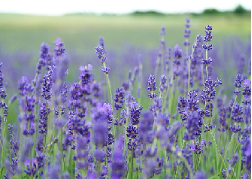
Fyffe House
If you’re willing to go off the beaten track, a stroll to Fyffe House could be a great way to get the legs moving. As the town’s oldest surviving building, this heritage home is full of archives and tales from the 1800’s. It’s also situated among some incredible landscapes – picture snow-capped mountains, lush forestry and Kaikoura’s dramatic coastline. The trip to Fyffe house is just a gentle 45-minute walk from the town’s centre, with an entry fee of $10.
Kaikoura dolphin encounters
We’ve already labelled Kaikoura as New Zealand’s go to destinations for all things marine life – and this time, we’re talking dolphins. Just like whales, you’re pretty much guaranteed to rub shoulders (or fins) with a dolphin in Kaikoura. So if that sounds like you, jump on one of the Dolphin Encounter Tours. If you want to stay dry, feel free to work your camera from the boat. Or if you want to make a splash, you can dive in for just an extra $80. The choice is yours.
Tip: Book in advance, as meeting these social mammals is a popular activity. Plus, catching the Coastal Pacific from Christchurch to Kaikoura means you’ll arrive just before the lunchtime tour kicks off.
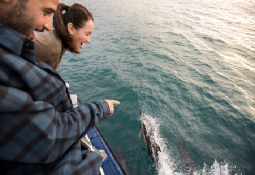
Kaikoura museum
If the weather packs up and you’re after something indoors, head to the incredibleKaikoura Museum. Having been dubbed ‘the mini Te Papa’ and ‘Craypot’ (because of its shape), there’s an array of storytelling displays, natural history to read up on and unique artifacts to explore. Of particular mention is ‘The New Normal’ exhibition – a series of stories dedicated to sharing the events of the 2016 Kaikoura earthquake from the locals who experienced it.
Note: Tickets are $10 for seniors and $12 for adults.
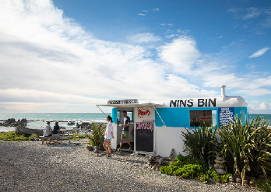
Catch your own meal
Kaikoura’s known as one of New Zealand’s best destinations for fishing, so if you’re a seasoned expert, or just like the sound of catching your own meal, sign up for a fishing trip with Kaikoura Fishing Charters. With several different tours to choose from, be it two, three or four hours, you can spend however long you wish at sea. Expect to walk away with some fresh catch and incredible memories - you might even spot a friendly dolphin. And just so you're preapred, pack warm clothes, snacks and a camera.
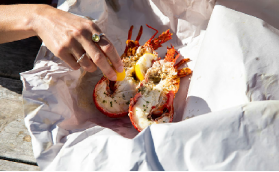
Albatross encounters
Majestic takes form in the Albatross bird. And Kaikoura is home to twelve species, as well as shearwaters, petrels, gannets, skuas, terns and more. While you could try spotting them yourself, an albatross encounters tour will give you real insight into these incredible creatures, so we’d say it’s worth every penny. Better still, you’re likely to come across other friendly locals – most visitors see dolphins, penguins and a seal colony or ten.
Tip: The best guys to get you up close are Albatross Encounters. Their tours run for two and a half hours – and depart at 9am and 1pm daily.
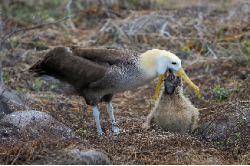
Kaikoura beach
If the sun’s out and you’ve only an hour to spare, a walk along Kaikoura’s beach could be a great way to break up the journey. Located in front of Kaikoura’s township, it has all the right ingredients. To paint a picture: think snow-capped mountains, wildlife life roaming freely and crisp mountain air, giving you a healthy dose of oxygen. Of course, if you’re here during summer, or want to brave the cold, the southern end of the beach is a great place to cool off (with the surf being less than one metre).
Tip: Check the Kaikoura weather report if you’re planning a day at the beach.
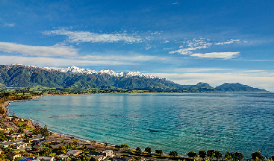
Kaikoura peninsula walkway and seal colony
If you’d rather avoid having to shake sand from your shoes, the Kaikoura Peninsula Walkway is walk that’s equally fantastic. The entire track is 11km, suitable for all fitness levels and takes roughly three hours to complete. If you’re pressed for time or just not a big walker but want to see the seal colony, there are shorter parts of the track you can do. Expect stunning views of Kaikoura’s Range, seal colonies bathing on rocks (look but don’t touch) and pockets of history to read up on.
Tip: Head to the Kaikoura i-Site Info Centre for directions.
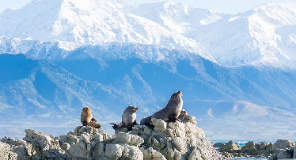
Kaikoura farmers’ market
If you’re passing through on a Sunday, a trip to Kaikoura’s farmers’market is a great way to mix with locals. Open from 10am-12am, you’ll find everything from organic produce, to fresh catch, to homemade baking, to artisan goodies, to beautifully crafted ceramics. The market is located at the west end of Kaikoura, not far from the town centre – and the railway station.
Note: The market runs from April through to November each year.
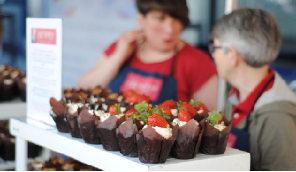
Hop aboard the Coastal Pacific train to Kaikoura
While it’s easy to go for the big and familiar, exploring some where new can be a great way to step out of your comfort zone. So if you’re ready to take the plunge, hop aboard the Coastal Pacific train and discover all the great things to do in Kaikoura. Running along the east coast of the South Island, you’ll experience 98km of stunning scenery, friendly service and an exquisite menu to tuck into (we’re talking hot and cold dishes, South Island wine, sweet treats and more).
Better still, with the flexi or flexi-plus pass, you have the freedom to make as many or as few stops as you like. So whether your journey is from Christchurch to Kaikoura or Picton to Kaikoura, stopping off (or staying put) at this South Island pocket of paradise could be just the adventure you’re after. What are you waiting for? The 2019/2020 season starts on 27th September, so make your booking on the Coastal Pacific today!
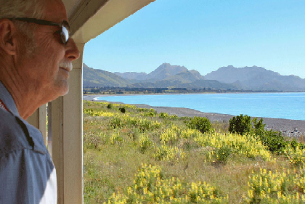
https://www.greatjourneysofnz.co.nz/blog/tick-kaikoura-off-your-must-do-list/
VI. History and Culture
The Kaikoura Peninsula extends into the sea south of the town, and the resulting upwelling currents bring an abundance of marine life from the depths of the nearby Hikurangi Trench. The town owes its origin to this effect, since it developed as a centre for the whaling industry. The name ‘Kaikoura’ means ‘To eat crayfish’ (‘kai’- to eat, ‘koura’ – crayfish) and the crayfish industry is a major contributor to the economy of the region. However Kaikoura is now one of the most popular tourist destinations in all of New Zealand – and it’s whales and dolphins are the major drawcards!
Kaikoura Ranges
The Kaikoura Ranges are two parallel ranges of mountains in the northeast of the South Island of New Zealand.
Formed along New Zealand’s Alpine Fault, they can be seen as the northernmost extension of the Southern Alps in the South Island.
Named the Looker-on mountains by Captain James Cook, they take their name from the town of Kaikoura at the southern extreme of the more eastern range, the Seaward Kaikouras. This range rises straight from (and dominates) the coast to the north of the town, and reaches its highest point with the 2610-metre Mount Manakau.
The long straight river valley of the Clarence River separate the Seaward Kaikouras from the longer and loftier Inland Kaikouras. This latter range contains the highest peak in the ranges, the 2880-metre Tapuae-o-Uenuku, the translation from the Maori of which is the poetic “Footprint of the rainbow”. Beyond the Inland Kaikouras is the valley of the Awatere River, which runs parallel to that of the Clarence.
The two ranges are visible from a great distance, including from the southern coast of the North Island.
Kaikoura Peninsula
The Kaikoura Peninsula is located in the northeast of New Zealand’s South Island. It protrudes five kilometres into the Pacific Ocean.The town of Kaikoura is located on the north shore of the peninsula.
The peninsula has been inhabited by Maori for the best part of 1000 years. They used it as a base for hunting moa, and also harvested the plentiful crayfish which are found along the shore. In legend, it was from this peninsula that legendary hero Maui is reputed to have dredged up the giant fish that became the North Island.
During the 19th century, European whaling stations were established in the area. In more recent times, the whales that visit the coast off the peninsula have been allowed to thrive, and whale-watching kaes the area a popular ecotourism destination. Whales frequent these coastal waters because squid and other deep-sea creatures are brought from the deep Hikurangi Trench to the surface by the combination currents and steeply sloping seafloor.
https://kaikourawhalewatching.com/history/
Maori Tours Kaikoura
Join a half-day tour combining laughter, learning and storytelling with hands-on activities like weaving and a bush walk to discover traditional uses of plants. As you join in the customs and traditions, you’ll gain deep insight into Maori people, their way of life, values and spiritual connections to the natural world. Bookings essential.
http://www.destination-nz.com/directory-nz/maori-tours-kaikoura/
VII. Contact Information
Mayor Craig Mackle
Phone: 0274 375 640
Email: Mayor@kaikoura.govt.nz
Deputy Mayor Julie Howden
Phone: 0275 432 559
Email: julie.howden@kaikoura.govt.nz
PO Box 6
Level 2, 96 West End
Kaikōura
Phone: 03 319 5026
Email: kdc@kaikoura.govt.nz
https://www.kaikoura.govt.nz/our-council/mayor-and-councillors/
